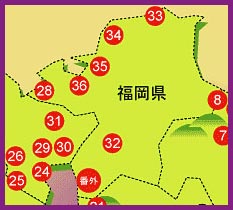. 九州三十六不動尊霊場 Kyushu - 36 Fudo temples .
:::::::::::::::::::::::::::::::::::::::::::::::::::::::::::::::::::::::::::::::::::::::::::::::::::::::
- Fukuoka 福岡県
32 清岩寺 開運厄よけ不動 - Kaiun Yakuyoke Fudo
33 不動院 身代り不動尊 - Migawari Fudo
34 鎮国寺 波切り不動 - Namikiri Fudo
35 恵光院 五鈷不動 - Goko Fudo
36 東長寺 結願不動 - Ketsugan Fudo
Some Temples also belong to the Henro Pilgrimage.
This number is given in brackets (xx).

source : setokeiichiro.com
:::::::::::::::::::::::::::::::::::::::::::::::::::::::::::::::::::::::::::::::::::::::::::::::::::::::
32 Seiganji 清岩寺 Seigan-Ji
開運厄よけ不動 - Kaiun Yakuyoke Fudo
福岡県甘木市三奈木町三奈木15 / Fukuoka Amakishi

Fudo Statue in the hall 上動堂
- source and more photos : shikisokuzekuu.net/36hudou -
- quote -
Seiganji temple belongs to the Shingon sect Ninnaji school.
The temple was established inviting Eisai in 1175. Eiasi was a priest related to Ninnaji and so he stayed at this temple which faced the sea for fourteen years and dedicated himself in purchasing all the sutras the Sung ships brought into the country.
- source : m.6918thhakata.com -
The temple was later supported by
黒田忠之 Kuroda Tadayuki (1602 - 1654) and became the Kuroda clan temple.
The High Priest 法印正範大和尚 resided here.
The main statue is of 薬師如来 Yakushi Nyorai.
. Myōan Eisai, Myooan Eisai 明菴栄西 Myoan Eisai .
(1141 – 1215)
:::::::::::::::::::::::::::::::::::::::::::::::::::::::::::::::::::::::::::::::::::::::::::::::::::::::
Fudooin 不動院 Fudo-In
Nr. 33 (92) 大原山 Daigensan - 不動院
身代り不動尊 Migawari Fudo

福岡県北九州市門司区吉志171-3 / Kishi, Moji Ward, Kitakyushu, Fukuoka
On request of the Kamakura Bakufu government in 1244, 藤原親房 Fujiwara Chikafusa came to the region to supress the Heike completely. He changed his name to 門司 Moji and unified 6 districts under this name. In the course of history the region was governed by various local lords.
The temple is located in the South-Western part of the Moji peninsula and overlooks the 周防灘 Suo-Nada sea.
The founder of the temple, 心玉阿闍梨 Shingyoku Ajari, was the son of a rich farming family. He build it in 1863 as a place to pray for protection from fire and other natural disasters.
In the temple compound are some old trees and two special statues of Jizo Bosatsu
- miminashi Jizo 耳なし地蔵 Jizo without ears
- agonash Jizo アゴなし地蔵 Jizo without a jaw
.......................................................................

.......................................................................

shuin 朱印 stamp
- - - - - Homepage of the temple
- source : fudouin-kitakyushu.jp/guide.html
.......................................................................
- reference source : kyushyu88.com/temple92 -
. Agonashi Jizo Temples 腮無地蔵 .
:::::::::::::::::::::::::::::::::::::::::::::::::::::::::::::::::::::::::::::::::::::::::::::::::::::::
Chinkokuji 鎮国寺 Chinkoku-Ji
Nr. 34 (88) 屏風山 Byobusan - 鎮国寺
波切り不動 Namikiri Fudo

福岡県宗像市吉田966 / Yoshida, Munakata, Fukuoka
Founded by Kobo Daishi in 806, after he had visited 宗像大社 Munakata Shrine.
He carved statues of the three deities venerated at Munakata,
大日如来 Dainichi Nyoria, 釈迦如来 Shaka Nyorai and
薬師如来 Yakushi Nyorai.
Then he carved Fudo Myo=O to protect the people from all kinds of disaster.
「真言秘密の大法を伝え得たるは、
危難をお救い下さった不動明王様のお蔭に他ならず」
The temple is known for its beautiful blossoms in all seasons.
.......................................................................

秘仏身代わり不動明王立像
The statue of Fudo inside the temple is a hibutsu 秘仏 hidden statue.

shuin 朱印 stamp

profile of the priest
- - - - - Homepage of the temple
- source : chinkokuji.or.jp
.......................................................................
- - - - - Yearly Festivals 年中行事
4月28日 - April 28 fire ceremony for the hidden Fudo Statue
秘仏身代わり不動明王立像の年に一度の御開扉があり、火渡り柴灯護摩供が奉修されます。
:::::::::::::::::::::::::::::::::::::::::::::::::::::::::::::::::::::::::::::::::::::::::::::::::::::::
35 恵光院 五鈷不動 Eko-In - Goko Fudo
瑠璃山医王密寺 Rurisan Iomitsu-Ji

灯籠堂
福岡県福岡市東区馬出5-36-35 / Fukuoka, Higashiku, Maidashi
Founded by 黒田忠之 Kuroda Tadayuki (1602 - 1654), the lord of the 筑前国 domain.
- - - - - Homepage of the temple
- source : hakataboy.com/temple
:::::::::::::::::::::::::::::::::::::::::::::::::::::::::::::::::::::::::::::::::::::::::::::::::::::::
Toochooji 東長寺 Tocho-Ji / 東長密寺 Tochomitsu-Ji
Nr. 36 (01) 南岳山 Nangakuzan - 東長寺
結願不動 - Ketsugan Fudo
This is the last temple of the Kyushu Fudo Pilgrimage.
ketsugan, kechigan means the fulfillment of the vow to complete a pilgrimage.

福岡市博多区御供所町2-4 / Gokushomachi, Hakata Ward, Fukuoka
The temple was founded by Kūkai Kobo Daishi, who had come back from his travels to China and landed in Hakata.
It was completed in 806, making it the oldest Shingon temple in Kyushu.
The main statue is a standing Kannon with 1000 arms and 11 faces.
十一面千手観音 Juichimen Senju Kannon
The temple had the strong support of 黒田家墓 Kuroda Tadayuki (1602 - 1652), the second lord of Fukuoka province, who has his grave in the temple compound.
The temple is also Nr. 24 on a pilgrimage to
九州24地蔵 24 Jizo Bosatsu temples in Kyushu.

- photo by Bradford of facebook -
Fukuoka Daibutsu (Great Buddhist statue)
The carving of the statue started in 1988 and it took 4 years to finish. The statue is 10.8 meters in height and 30 tons in weight. This is the largest statue of a seated Buddha among the ones in Japan. The ring of light behind the Buddha stands 16.1 meters in height and is carved with numerous images of Buddha. Besides the statue is a treasure exhibition hall.
- source : wikipedia -
.......................................................................

source : setokeiichiro.com
.......................................................................

- - - - - Homepage of the temple
- source : akatanomiryoku.com
.......................................................................
- - - - - Yearly Festivals 年中行事
1月 1日 新春はつもうで
2月 3日 節分大祭
3月21日 正御影供
6月15日 弘法大師誕生祭 Birthday of Kobo Daishi
8月16日 大施餓鬼会
10月20日 土砂加持法要
............................................................................
東長寺 Tocho-Ji is the last temple of the Fudo Pilgrimage
and the first of this one :
. 九州88ヶ所108霊場 Kyushu - 88 and 108 Henro temples .
. Pilgrimages to Fudo Temples 不動明王巡礼
Fudo Myo-O Junrei - Introduction .
............................................................................
- - - reference - coara.or.jp/~rinsaiji 福岡県 - - -
:::::::::::::::::::::::::::::::::::::::::::::::::::::::::::::::::::::::::::::::::::::::::::::::::::::::::::::::::::::::::::
. Narita Fudo 成田不動尊 .
Temple Shinshooji 新勝寺 Shinsho-Ji
. O-Mamori お守り Amulets and talismans from Japan .
. Japanese Temples - ABC list - .
[ . BACK to WORLDKIGO . TOP . ]
[ . BACK to DARUMA MUSEUM TOP . ]
- #fukuokapilgrims #tochoji #ketsuganfudo -
:::::::::::::::::::::::::::::::::::::::::::::::::::::::::::::::::::::::::::::::::::::::::::::::::::::::::::::::::::::::::::





































